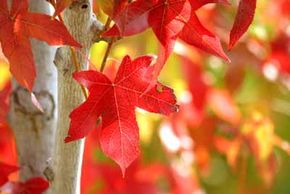Sweet gum tree is a tall, majestic tree that's difficult to beat for symmetrical beauty in a landscape setting. Although native to eastern North America, it is widely planted throughout the continent in its range.
Advertisement
Description of sweet gum tree: The sweet gum has a pyramidal habit when young, eventually becoming rounded and tall -- up to more than 100 feet. The bark is grayish brown and deeply furrowed. Stems often have corky and attractive wings during the second year. The deciduous leaves are maplelike in outline, with five pointed lobes and lightly toothed margins. They are deep, glossy green in summer and turn yellow to purple-red in the fall. Its fruit cluster is a round ball often persisting in winter, as if the naked branches had been hung with woody Christmas ornaments.
Growing sweet gum tree: Transplant when young -- the sweet gum resents root disturbance when it matures. Often, newly planted trees will scarcely grow at all for the first two or three years. Although this tree normally grows on rich, moist soils in the wild, it has proven itself quite adaptable in culture. In fact, it is one of the most pH-tolerant of all trees, thriving equally well in acid or alkaline conditions.
Uses for sweet gum tree: The sweet gum is a perfect choice for parks, large lots, and street plantings (as long as the tree's massive roots are not in the way). The tree is particularly choice when it changes color in fall.
Sweet gum tree related species: The Formosan sweet gum (Liquidambar formosana) is similar to the native sweet gum but with three-lobed leaves. It is not as hardy as the native species.
Scientific name of sweet gum tree: Liquidambar Styraciflua
Advertisement
